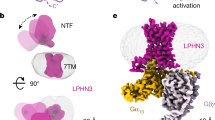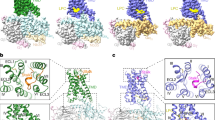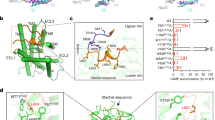Abstract
The manner in which a membrane protein is anchored to the lipid bilayer may have a profound influence on its function. Most cell surface membrane proteins are anchored by a membrane-spanning segment(s) of the polypeptide chain, but another type of anchor has been described for several proteins: a phosphatidyl inositol glycan moiety, attached to the protein C terminus1,2. This type of linkage has been identified on membrane proteins involved in adhesion3 and transmembrane signalling4,5 and could be important in the execution of these functions. We report here that an immunologically important adhesion glycoprotein, lymphocyte function-associated antigen 3 (LFA-3), can be anchored to the membrane by both types of mechanism. These two distinct cell-surface forms of LFA-3 are derived from different biosynthetic precursors. The existence of a phosphatidyl-inositol-linked and a transmembrane anchored form of LFA-3 has important implications for adhesion and transmembrane signalling by LFA-3.
This is a preview of subscription content, access via your institution
Access options
Subscribe to this journal
Receive 51 print issues and online access
$199.00 per year
only $3.90 per issue
Buy this article
- Purchase on Springer Link
- Instant access to full article PDF
Prices may be subject to local taxes which are calculated during checkout
Similar content being viewed by others
References
Low, M. G. Biochem. J. 244, 1–13 (1987).
Cross, G. A. M. Cell 48, 179–181 (1987).
He, H. T., Barbet, J., Chaix, J. C. & Goridis, C. EMBO J. 5, 2489–2494 (1986).
Kroczek, R. A., Gunter, K. C., Germain, R. N. & Shevach, E. M. Nature 322, 181–184 (1986).
Reiser, H. et al. Cell 47, 365–370 (1986).
Springer, T. A., Dustin, M. L., Kishimoto, T. K. & Marlin, S. D. A Rev. Immun. 5, 223–252 (1987).
Vollger, L. W., Tuck, D. T., Springer, T. A., Haynes, B. F. & Singer, K. H. J. Immun. 138, 358–363 (1987).
Plunkett, M. L., Sanders, M. E., Selvaraj, P., Dustin, M. L. & Springer, T. A. J. exp. Med. 165, 664–676 (1987).
Makgoba, M. W., Shaw, S., Gugel, E. A. & Sanders, M. E. J. Immun. 138, 3587–3589 (1987).
Selvaraj, P. et al. Nature 326, 400–403 (1987).
Dustin, M. L., Sanders, M. E., Shaw, S. & Springer, T. A. J. exp. Med. 165, 677–692 (1987).
Hunig, T., Tiefenthaler, G., Meyer zum Buschenfelde, K.-H. & Meuer, S. C. Nature 326, 298–301 (1987).
Bierer, B. E. et al. Fedn Proc. 46, 1498 (abstr. 6894) (1987).
Selvaraj, P., Dustin, M. L., Silber, R., Low, M. G. & Springer, T. A. J. exp. Med. 166, 1011–1025 (1987).
Davitz, M. A., Low, M. G. & Nussenzweig, V. J. exp. Med. 163, 1150–1161 (1986).
Kornfeld, R. & Kornfeld, S. A. Rev. Biochem. 54, 631–664 (1985).
Wallner, B. P. et al. J. exp. Med. 166, 923–932 (1987).
Braell, W. A. & Lodish, H. F. J. biol. Chem. 256, 11337–11344 (1981).
Barthels, D. et al. EMBO J. 6, 907–914 (1987).
Le, P., Denning, S., Springer, T., Haynes, B. & Singer, K. Fedn Proc. 46, 447 (1987).
Ishihara, A., Hou, Y. & Jacobson, K. Proc. natn. Acad. Sei. U.S.A. 84, 1290–1293 (1987).
Singer, S. J. In Surface membrane receptors. Interface between cells and their environment, (eds Bradshaw, R. A., Frazier, W. A., Merrell, R. C. & Gottlieb, D. I.) 1–24 (Plenum, New York 1976).
Sastre, L., Kishimoto, T. K., Gee, C., Roberts, T. & Springer, T. A. J. Immun. 137, 1060–1065 (1986).
Gielkens, A. L. J., Van Zaane, D., Bloemers, H. P. J. & Bloemendal, H. Proc. natn. Acad. Sci. U.S.A. 73, 356–360 (1976).
Kürzinger, K. & Springer, T. A. J. biol. Chem. 257, 12412–12418 (1982).
Hoessli, D. & Rungger-Brandle, E. Expl cell Res. 156, 239–250 (1985).
Lublin, D. M., Krsek-Staples, J., Pangburn, M. K. & Atkinson, J. P. J. Immun. 137, 1629–1635 (1986).
Author information
Authors and Affiliations
Rights and permissions
About this article
Cite this article
Dustin, M., Selvaraj, P., Mattaliano, R. et al. Anchoring mechanisms for LFA-3 cell adhesion glycoprotein at membrane surface. Nature 329, 846–848 (1987). https://doi.org/10.1038/329846a0
Received:
Accepted:
Issue Date:
DOI: https://doi.org/10.1038/329846a0
This article is cited by
-
CD58 acts as a tumor promotor in hepatocellular carcinoma via activating the AKT/GSK-3β/β-catenin pathway
Journal of Translational Medicine (2023)
-
Upregulated CD58 is associated with clinicopathological characteristics and poor prognosis of patients with pancreatic ductal adenocarcinoma
Cancer Cell International (2021)
-
IFN signaling and neutrophil degranulation transcriptional signatures are induced during SARS-CoV-2 infection
Communications Biology (2021)
-
CD58 mutations are common in Hodgkin lymphoma cell lines and loss of CD58 expression in tumor cells occurs in Hodgkin lymphoma patients who relapse
Genes & Immunity (2016)
-
CD58, a novel surface marker, promotes self-renewal of tumor-initiating cells in colorectal cancer
Oncogene (2015)
Comments
By submitting a comment you agree to abide by our Terms and Community Guidelines. If you find something abusive or that does not comply with our terms or guidelines please flag it as inappropriate.



